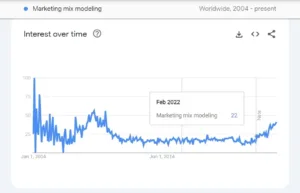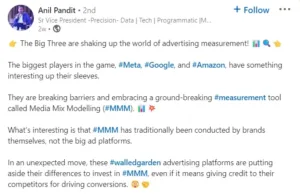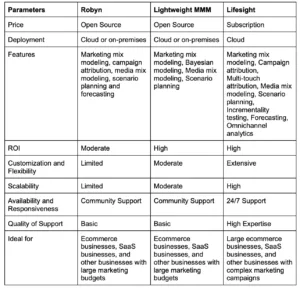When was the last time you heard somebody talk about Marketing Mix Modeling?
During a strategic meeting, set up your plan of action for BFCM?
While working on the budgets with the finance team for the next quarter?
You heard about it at a marketing conference you attended recently?
Or perhaps you came across a post on LinkedIn talking about how MMM will help you save money?
In any case, if you are working in marketing, specifically involved in ads, you must have come across the term Marketing Mix Modeling or MMM.
And rightly so; MMM has been around since the 1960s, but there are specific reasons why it is on the rise again.
Firstly, marketing as a landscape is constantly evolving, with data-driven decisions gaining more prominence. This has made ROI optimization more critical than ever. MMM acts as an indispensable compass in this realm, guiding marketers through the network of consumer behavior, campaign performance, and budget allocation.
Secondly, we are slowly moving to a world where marketers are forced to rely less on cookies and more on customer privacy. Marketers are heavily dependent on their customer data to fuel customer acquisition & retention strategies and achieve ROI.
All these developments in the marketing realm are leading a marketer toward MMM.
”MMM also circumvents a few challenges we often have trouble with when using other methods like multi-touch attribution, such as errors in online activity when it comes to bots and false impressions, and the fact that it can measure a much wider variety of aspects than other methods, namely seasonality, promotions, local and national advertising (both on and offline), PR, social media, and even regional weather impacts.”
– Christopher Martin, CEO at Media.Monks
However, understanding you need MMM to navigate the cookie-less is just the first step. Deciding how you go about implementing it has the power to make or break your strategy.
There are generally four ways to implement MMM in your marketing:
- Building it in-house
- Hiring a media agency
- Consultancy based
- AI-based and automated solutions
In this blog post, we will be digging deeper into the fourth way from above – getting a vendor who provides AI-based and automated solutions.
Let’s understand why Marketing Mix Modeling is critical for your business
The Importance of Marketing Mix Modeling
In simple terms, marketing mix modeling is a statistical analysis technique that marketers use to measure the impact of different marketing activities on sales or other key performance indicators (KPIs). It is a way of understanding how much each marketing activity contributes to the overall success of a campaign. This is done by scrutinizing historical data and applying statistical techniques like regression.
With the insights derived from MMM, businesses can strategically allocate resources where they matter the most and tune them further to get the best returns on their spend.
The result?
A data-based prediction of getting a higher ROI and making more efficient use of marketing budgets.
“MMM allows us to understand where sales growth comes from year over year while also delivering ROIs by channel. This allows businesses to evaluate not only things like price elasticity, promotional profitability, and marketing ROI but also allows for media optimization across channels, regions, products, seasonality, and whatever strategic objectives have been set (whether that be brand building, profit, growth, and so on) and forecasting or scenario planning to understand the risks and rewards of one investment choice versus another.”
– Christopher Martin, CEO at Media.Monks
Here are two major reasons why MMM is absolutely critical for your business
1) Attribution Analysis: Simplifying the Complex Path to ROI
A customer’s journey to conversion is very much like a jigsaw puzzle. It can involve various measurable touchpoints like website interactions, social media engagement, emails, and various non-measurable touchpoints like word-of-mouth, brand awareness, and offline experiences.
While traditional attribution models can help you identify these touchpoints, they fall short in deciphering the ROI on the spends on each of these touchpoints.
Marketing Mix Modeling on the other hand goes two steps ahead and analyzes the historical performance of these touchpoints. By applying statistical techniques, it uncovers how much ROI you are getting out of each of these channels. This level of depth helps you allocate the right budgets to every channel so that your spend is optimized.
For instance, a traditional attribution model might help you identify the various touch points a customer interacted with before conversion, Marketing Mix Modeling on the other hand adds weightage to these touchpoints in terms of ROI achieved. This insight helps you accurately identify the high-performing channels and adjust your budgets accordingly.
2) Budget Allocation: Getting the Best out of Every Dollar
Budget allocation is tricky and can spell the difference between success and missed opportunities. Most marketers usually go by their gut instinct or “trend”. However, how confident can they be in their decisions?
MMM allows you to optimize your budget allocation purely based on data. It provides a comprehensive view of how all of your marketing channels perform and what their relative impact on ROI is, helping you make confident budget decisions.
For instance, if you are using multiple channels like TikTok, Facebook, Google, and Print, MMM can accurately pinpoint what revenue each channel is bringing to the table. With such clarity, you can confidently allocate your budget toward the channels that make the greatest impact, ensuring that your marketing dollars are working harder and smarter.
Now that we are clear on the impact of MMM on your business, let’s delve into why your MMM vendor matters significantly. Especially how this choice can make or break your marketing success.
Why Your MMM Vendor Choice Matters
Evaluating an MMM vendor is akin to a homebuyer meticulously inspecting a house for purchase. Just as the homebuyer might examine every aspect of the house – its location, size, condition, and neighborhood a marketer needs to scrutinize various factors of an MMM vendor to ensure it’s the right fit for their needs.
The goal is pretty much the same in both scenarios, make a significant and long-term investment that does not make you repent later.
Friendly Advice: Do not get allured by the popularity of the vendor. Carry out a meticulous assessment of factors such as price, features, customer support, and any other factor you deem important.
Here are two things you need to understand before you start approaching a vendor
Long-Term Partnership
Imagine a vendor as a compass that guides your marketing ship. If they lead you in the wrong direction, you might end up in a far worse place than before. At the same time, you cannot just seek direction once and follow the course. As and when the external factors change, your vendor will have to tweak their solution accordingly to ensure you are always on track toward your goal.
The partnership between you and the vendor needs to evolve with your business’ growing needs and challenges. Your MMM vendor should be able to align with your evolving needs, offering support and solutions.
Cost of Mistakes
The consequences of a misaligned choice can be financially substantial. Unforeseen expenses, hidden fees, overpriced solutions, all these can drain your marketing budgets faster and impact your ROI.
But the cost goes deeper.
An unsuitable vendor can lead to inaccurate insights, missed opportunities, and misallocated resources. And not just that, the cost extends to time as well – a resource that is paramount in today’s fast-paced business landscape.
The longer you stay with an unsuitable vendor, the more time you lose. And lost time equates to lost revenue and market share.
Several UMM / MMM software solutions are available on the market. From BYO with existing open-source libraries such as Google’s Lightweight MMM and Meta’s Robyn MMM to paying for full-fledged SaaS MMM solutions. Something to be aware of: BYO could mean – getting additional headcount internally could take very long, or the possible support could be too small because of other internal priorities.
– Stephen Goetze, MarTech Consultant
The Three Important Factors in Evaluating an MMM Vendor
Evaluating Price: More Than Meets The Eye
On the surface, pricing looks very simple. You compare the quotes presented by different vendors and make a decision. But it’s not as simple as that.
Pricing can be more complicated than it seems and a short-sighted approach can lead to some unwanted challenges down the road.
Hidden Costs: What’s the True Price Tag?
David is a Vendor Manager at one of our customers. He went with a vendor by looking at the surface-level price and did not bother to delve deeper into the realm of hidden costs. This mistake of his came to the surface when they were billed for additional fees.
We do not want you to go through what David went through.
When David came to us, we asked him to always check for three specific things when a vendor sends over a quote:
- Set-up Fees:
This is the most common hidden cost in the MMM landscape. This fee might not seem harmful, but it can significantly impact your budget. If you are speaking to an MMM vendor, always inquire about setup fees and ensure they fit into your budget.
- Additional Feature Costs:
MMM vendors can present a plethora of features and serve you the “best MMM solution”. Take a step back and evaluate whether you need all those features in the first place. In most cases, companies do not need as many features in the first place. Moreover, you can always upgrade your solution later
- Penalties:
Would you like to receive an invoice that charges you a bomb for exceeding your usage? No, right?
There might be times (like the holiday season) when you exceed your agreed-upon usage limits. At times like these, some vendors impose penalties or extra charges. Ensure you are aware of such potential costs and have the flexibility to stretch your usage without incurring hefty fees.
ROI of Vendor Services: Beyond the Bottom Line
One of the most important things to remember while evaluating a vendor is to focus more on the value you get vs. the money you spend. Humans always make decisions based on their emotions and everybody likes a good price. However, if you don’t get a substantial return on what you pay, it can quickly become an expensive mistake.
While evaluating a vendor, first focus on the impact it has on your marketing strategy and ROI. Always look at a good value vs. price ratio. But at the same time, don’t go overboard by paying humongous amounts of money.
For instance, an expensive vendor might offer additional services, custom support, or features that can bring in a higher ROI. Even though the price is higher, you will get a better ROI. However, if you don’t need these additional services, you will be paying extra for something that you are never going to use.
Remember that your objective is to choose the MMM vendor that gives the best overall value rather than the lowest alternative. Making an informed decision that will benefit your marketing efforts for years to come requires balancing cost-effectiveness with the possibility of a higher ROI.
Assessing Features: Getting an MMM Solution Tailored to Your Needs
Your business is unique with its own strategies, goals, and challenges. Therefore, it’s paramount to assess the features provided by a potential MMM vendor through the lens of your unique requirements. Consider this when purchasing a home with specific requirements like a pool, patio, a fixed number of bedrooms, etc. Getting a home with more than you need might look enticing, but would you be able to make the best use of it?
Customization and Flexibility: Your Business, Your Rules
In Marketing Mix Modeling, one size never fits all. The more customization and flexibility you can get from an MMM solution, the higher the chances of a successful implementation.
It’s very much like getting a suit tailored to fit you perfectly. You would want it to enhance your strengths and look exactly as you want. Your MMM solution too, should be able to seamlessly integrate with your existing infrastructure, data sources, and industry. This will ensure that your MMM solution is as relevant to your business as possible and at the same time, super actionable.
Here are some questions you can ask your vendor while evaluating their MMM solution:
- Can the solution be tailored to accommodate your unique data sources and metrics?
- Is the solution modular enough to let you choose the components that fit your requirements?
- Does it address the dynamics of the market, seasonality, and other regional variations in its analysis?
These questions will help you evaluate the features of an MMM solution and give you a clear idea of whether or not they fit your business needs.
Scalability: Growing Without Limits
A marketing function that generates 10 million USD every year functions very differently from a function that generates 10x of that. Even though both of these groups might be using the same MMM solution, their requirements will change due to the scale.
A smaller marketing function might require fewer features, but as they grow, they will need a more capable solution that can grow with their needs. Addressing this at the beginning would be a huge advantage for your business, preventing any overhaul of your MMM infrastructure later.
Here are some considerations to assess the scalability of an MMM solution:
- Can the solution handle an increased volume of data? If yes, what’s the upper limit?
- Is there room for adding more users to the solution and running multiple concurrent analyses without affecting performance?
- Is the vendor innovative enough to continuously improve their solution with the changing marketing landscape?
The relationship between your vendor and your business is not merely a transaction, but a partnership that has the potential to lead to long-term success. Assessing a solution just on the grounds of your current needs is a very myopic way to approach a vendor. Assessing a solution’s scalability would act like an insurance policy for your business’s future growth and success.
Importance of Customer Support: A Bridge to MMM Success
Having amazing features on paper and implementing them in your business are two different things. More often than not, you will need some support in customizing your solution, implementing a feature or even addressing a post-implementation issue. In times like these, most businesses understand the importance of good customer support.
Let’s get deeper into why you cannot overlook customer support when choosing your MMM solution
Availability and Responsiveness: Being Present is Assuring
Imagine you are using your MMM solution to plan your marketing campaigns for the holiday season and you come across some issues. Would you want to solve this problem with high precision and speed or would you want to wait for some days to hear from a chatbot that leads you to a knowledge database that possibly has the solution to your problem?
In marketing, time is a very important resource. Any delay in addressing such challenges might lead to a lost opportunity, overspending, or worse, incorrect decisions. This makes it highly imperative for you to ensure that your vendor offers responsive customer support and can assist whenever you encounter such hiccups.
And by responsive, we don’t mean sending out an email saying they have registered your problem and will get back to you. It’s understanding that every moment counts in marketing and committing to resolve issues effectively and efficiently.
Quality of Support: Going Beyond Answers and Delivering Insights
Good vendors offer support and provide solutions, but the best ones are a source of valuable insights and a partner in success.
An ideal vendor doesn’t merely answer queries but takes a step further to understand your MMM implementation and help you get the most out of it. They dive deep into your data, understand your requirements, and offer strategic recommendations to increase the value derived from their solution.
Look for vendors who not only address symptoms but are proactive in diagnosing issues and offering solutions to improve your MMM performance. Whether it’s identifying untapped opportunities, optimizing resource allocation, or fine-tuning your models for better accuracy, a supportive vendor should be your partner in continuous improvement.
In conclusion, when you are evaluating multiple MMM vendors, don’t just look at their features, also evaluate their customer support to ensure you get a strategic partner. A vendor that offers top-notch customer support can be dedicated to your journey to building a successful business.
Robyn vs. Lightweight MMM vs. Lifesight
With MMM taking center stage in most marketing discussions, ad platforms like Facebook, Google, and Amazon have also started coming up with their own MMM solutions to help you get a better understanding of how exactly your marketing is giving you value.
This to some extent, is surprising as mentioned by Anil Pandit, SVP at Publicis Media. With ad platforms themselves jumping on the MMM bandwagon, it gives businesses better options to evaluate their ideal MMM solution.
To help you get a better understanding of how these open-source solutions fare against vendor-provided solutions, we’ve compared three MMM solutions: Robyn, Lightweight MMM, and Lifesight. We’ve analyzed each provider’s offerings and considered key factors that should guide your choice.
Conclusion
Selecting a vendor is more than simply a business transaction; it’s a strategic decision that affects your entire marketing environment.
The effects of your decision reverberate throughout your company, impacting the very core of your marketing performance. It influences how you set budgets, use data to guide decisions, and adjust to the always-shifting customer landscape. In essence, it creates the conditions for the success of your brand.
Now that you understand the importance of choosing the right MMM vendor, embark on the next phase by taking a proactive stance toward driving your business toward data-driven excellence. Sign up for a personalized demo with Lifesight’s Marketing mix model to see how we can help you move closer to a future where data-driven decisions empower your marketing strategy, where ROI knows no limits, and where your brand reaches new heights of success.
You may also like
Essential resources for your success



















